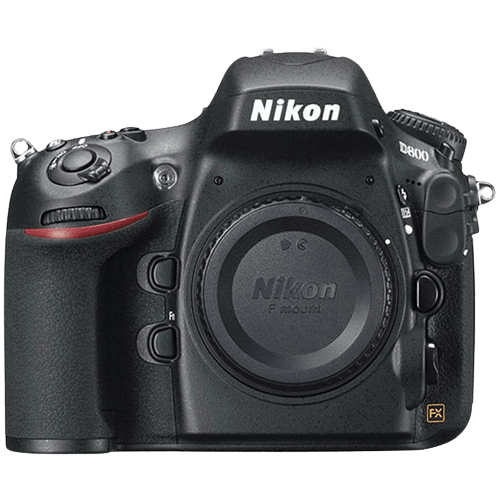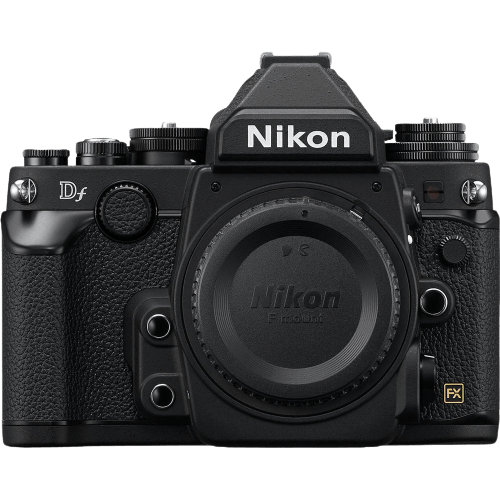Nikon D800 vs Df Comparison
Nikon D800

Nikon Df

The Nikon D800 outperforms the Nikon Df with a score of 69/100 compared to 58/100. Both cameras are DSLRs released in 2012 and 2013, respectively. They share common specifications, such as similar camera sizes and launch prices ($2,999 for the D800 and $2,749 for the Df).
The D800 excels with its higher score and larger dimensions (146 x 123 x 82mm) compared to the Df (144 x 110 x 67mm). This size difference results in a more substantial and robust feel. However, the Df has a lighter weight at 760g, making it more portable and easier to carry than the D800, which weighs 1000g.
Though the D800 has a higher score and offers a more professional feel, the Df’s lighter weight and slightly lower price point might make it the better choice for casual photographers. Ultimately, the decision depends on each individual’s preferences and needs.
Nikon D800 vs Df Overview and Optics
The Nikon D800 takes the lead in optics with a score of 74/100, compared to the Nikon Df’s score of 60/100. Both cameras share some key specifications, such as the CMOS sensor type, Expeed 3 processor, full-frame sensor size, Nikon F FX lens mount, and lack of image stabilization.
The D800 outperforms the Df in several aspects. Firstly, the D800 has a significantly higher megapixel count at 36.3, compared to the Df’s 16.2. This results in greater image resolution and detail. Additionally, the D800 has a higher DXOMARK sensor score of 95, while the Df scores 89. This suggests that the D800’s sensor has better overall performance, including dynamic range, color depth, and low-light sensitivity.
On the other hand, the Nikon Df has a faster shooting speed, clocking in at 5.5 frames per second (fps) compared to the D800’s 4 fps. This makes the Df more suitable for capturing fast-moving subjects or action photography.
To summarize, the Nikon D800 is the superior camera in terms of optics, with a higher score, greater resolution, and better sensor performance. However, the Nikon Df offers a faster shooting speed, making it a better choice for specific photography situations. Ultimately, the choice between the two cameras depends on individual preferences and requirements.
Nikon D800 vs Df Video Performance
When comparing the video capabilities of the Nikon D800 and the Nikon Df, it is clear that the Df does not have any video functionality. This means that for those interested in capturing video, the D800 is the only option between the two cameras.
The Nikon D800 has a video score of 57 out of 100. It is capable of recording Full HD video at a maximum resolution of 1920 x 1080 pixels. Its maximum video frame rate is 30 frames per second, providing smooth motion capture for most situations. Additionally, the D800 features built-in time-lapse functionality, allowing users to create stunning time-lapse sequences without the need for additional equipment or software.
Considering the video capabilities, the Nikon D800 stands out as the clear choice for those who require a camera with video functionality. While the Nikon Df may be suitable for photographers who solely focus on still images, the D800 offers a more versatile option with its ability to capture high-quality video in addition to excellent still images.
Nikon D800 vs Df Features and Benefits
The Nikon D800 and Nikon Df both score 57 points in terms of features, making it a tie. These cameras share several specifications, such as a 3.2-inch screen size and a screen resolution of 921,000 dots. Neither camera has a touchscreen, flip screen, GPS, or Bluetooth. However, the Nikon D800 has Wi-Fi, while the Nikon Df does not.
The Nikon D800’s Wi-Fi capability gives it an advantage over the Nikon Df, as it allows for easy file transfers and remote camera control via a smartphone or tablet. This feature can be especially useful for photographers who need to share their images quickly or control their camera from a distance.
On the other hand, the Nikon Df does not offer any distinct advantages over the Nikon D800 in terms of features. The absence of Wi-Fi in the Nikon Df may not be a major drawback for some photographers, but it does limit the camera’s versatility in certain situations.
Given that the Nikon D800 and Nikon Df have identical scores and share most specifications, the choice between these cameras largely depends on individual preferences and specific needs. The Nikon D800’s Wi-Fi functionality gives it a slight edge for photographers who value convenient connectivity options. In contrast, the Nikon Df may be suitable for those who prioritize other aspects of camera performance and do not require Wi-Fi. Ultimately, both cameras offer similar features, and the decision should be based on the photographer’s unique requirements.
Nikon D800 vs Df Storage and Battery
The Nikon D800 outperforms the Nikon Df in storage and battery, scoring 71/100 compared to the Df’s 48/100. Both cameras accept the same memory cards, SD/SDHC/SDXC, and neither has USB charging. However, the D800 takes the lead with two memory card slots and compatibility with UHS-I SD cards and Compact Flash, offering more storage options.
The D800’s battery life is shorter at 900 shots, compared to the Df’s 1400 shots, using the EN-EL15 and EN-EL14 batteries respectively. Despite the longer battery life of the Df, the D800’s overall storage and battery performance is superior due to its additional memory card slot and compatibility with more memory card types.
In this comparison, the Nikon D800 proves to be the better choice for photographers seeking greater storage flexibility, while the Nikon Df may be more suitable for those prioritizing longer battery life.
Nikon D800 vs Df – Our Verdict
Are you still undecided about which camera is right for you? Have a look at these popular comparisons that feature the Nikon D800 or the Nikon Df:

